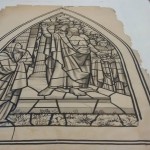The Rakow Research Library of The Corning Museum of Glass recently received a National Leadership Grant for Libraries; Collaborative Planning Grant from the Institute for Museum and Library Services (IMLS) to help conserve and digitize the Whitefriars stained glass cartoons collection. A cartoon is a full-scale drawing used to plan a stained glass window.

Whitefriars cartoon for the Eastman Memorial
Window designed for Park Church in Elmira,
NY, before conservation.
IMLS National Leadership Grants for Libraries support projects that address challenges faced by the library and archive fields. Successful projects have the potential to improve library services nationwide. The Rakow Library of the Corning Museum of Glass will develop an innovative methodology for preserving, digitizing, and making accessible a collection of approximately 5,000 to 7,000 large-scale, paper-based designs of historical significance.
James Powell and Sons, more popularly known as Whitefriars, was among England’s oldest and most prominent glass company, operating for more than 250 years before closing its stained glass business in 1973, and the rest of the company in 1980. The Museum of London acquired the Whitefriars’ extensive collection of design drawings and cartoons, but due to the impressive size of some of the works (more than 20 feet long in certain cases), storage proved to be an issue, and the Museum of London offered the cartoon collection to the Rakow. The gift was made in 2008, consisting of 1,800 rolls of cartoons, which contained between 5,000 and 7,000 works.
“Because we are the world’s leading museum on glass, and the library of record for glass, the Museum of London generously gave them to us,” said Jim Galbraith, chief librarian at the Rakow. “We are very happy to be partnering with the Museum of London on this project as it gives us a chance to bring the Whitefriars materials together. It’s unique to have a collection of a company’s work that is so complete. These cartoons are templates for the actual work of art, so they are life-size pieces that the artists would use to install the stained glass windows.”

Unrolling the conserved cartoon of
the Eastman Memorial Window
designed for Park Church in Elmira, NY.
Since the Whitefriars Collection is the largest of its kind owned by the Rakow, the conservation process will be an undertaking like no other project the Rakow has ever done.
“The cartoons arrived in plastic containers in a tractor trailer,” said Galbraith. “Since these were working design documents, once the company was done using them, there was no reason to store them in optimal conditions. We are happy the company had the foresight to save them.”
Galbraith notes that some of the cartoons they have already examined are pierced with small holes from being pinned to walls in the factory, display handwritten notes in the margins from the artists as they were working, and even have coffee ring stains.
The Rakow has separated the planning grant into three stages. The library is currently in phase one, which involves working with the Museum of London to select the first set of rolls to be preserved and digitized—roughly 15 rolls containing about 150 works. This will be determined based on important artists and installations, as well as local pieces of interest for both the Museum of London and the Rakow. Phase two will entail preserving the selected rolls, a process that will take approximately 3 months, then testing and evaluating the overall process. Finally, phase three will focus on planning a website for the digitized works, and a crowd-sourced database where people can share information about the collection.
When going through the list of the contents of the rolls, it was discovered that there were several cartoons from stained glass windows in Park Church in nearby Elmira, NY, which was affiliated with the abolitionist movement and several well-known personalities in the 1800s including Mark Twain and Thomas K. Beecher, brother of Harriet Beecher Stowe.
- The conserved cartoon of the Eastman Memorial Window designed for Park Church in Elmira, NY.
- Eastman Memorial Window designed by Whitefriars and installed in Park Church in Elmira, NY. The window’s title is “Paul Preaching On Mars Hill,” as the man standing atop the steps, preaching before a crowd, is likely Saint Paul.
“There’s a community feel to this collection,” said Galbraith. “Because there are so many different installations, and so many countries represented—roughly 30—it’s an opportunity, if we share the information, to have communities around the world trace the history and creation of these iconic art pieces.”
In the spring, the Rakow will begin working with West Lake Conservators to unroll the 15 pre-determined rolls in a temperature- and humidity-controlled environment that will be installed at the library. An internship program will also be created to provide valuable experience to students studying preservation and conservation.
A goal of this project is to provide a roadmap for museums and libraries on how to connect their digital collections with other institutions, diverse audiences, and their local communities—which aligns with the strategic goals of the IMLS.
“Once the cartoons have been digitized, we’ll make them available via a website, so that hopefully people at institutions around the world that have these stained glass windows installed will send pictures to us,” said Galbraith. “We want to connect the images of the real glass to the cartoons, and then to the presentation drawings that are held by the Museum of London. It’s an exciting process of discovery.”
Read more about this collection in previous posts.
This project was made possible in part by the Institute of Museum and Library Services (#LG-55-14-0110-14).
The Rakow Research Library is open to the public 9am to 5pm every day. We encourage everyone to explore our collections in person or online. If you have questions or need help with your research, please use our Ask a Glass Question service.



5 comments » Write a comment